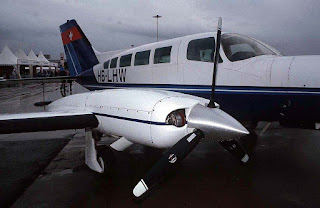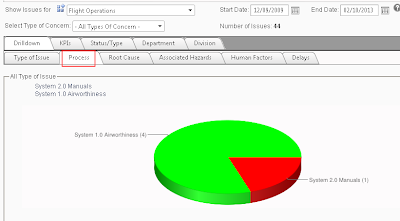Hazard Reporting for Airline/Airport SMS Programs
Hazard reporting is a very important element in any airport/airline safety management system. Having the ability to submit issues conveniently, regardless of their location, will ensure your organization will continue reporting. And yes, reporting is the first step in the aviation risk management cycle.SMS Pro™ offers many ways an issue will come into your airline/airport risk management database. The following ways allow airport and airlines convenient tools to get their issues into their hazard reporting system.
1) Regular Issue Reporting Module
User logs into your SMS Pro™ and submits issue using a pre-defined report. Reports may be of several types: either safety, security, quality, compliance or environmental. When companies require special data elements to be captured that are not available in SMS Pro™, NWDS can create the custom reporting form fairly easily.Users can report anonymously, or request that other users don't know that they reported the issue. In this case, users don't mind if managers know who reported the issue, but just don't want other employees to know.
Users can also report issues belonging to other divisions (or departments) in the organization.
Reported issues belong to a particular user's account. Users can view their reported issues and the status of these issues by going to the User Dashboard and looking under the "Reported Issues" tab.
Compliance issues from audits are easily entered using the Regular Issue Reporting module. This is a Web-based aviation SMS hazard reporting module that handles all types of issues.
2) Data Entry Person Entering Reports on Behalf of Others
Users with Data Entry role can submit reports on behalf of other users. Example, paper based reports are collected from the field, or your company wishes to enter past paper or MS Excel based reports into your airline/airport safety management system.3) Public Issue Reporting Module
In the second way, users have a Web link to Public Issue Reporting module. Any user with the link can use this module. In this case, the user does not require a username or password. This user still has the ability to report anonymously, just as in the first scenario. This scenario is perfect for customers or vendors reporting issues into your airline/airport hazard reporting system.Users accessing the Public Issue Reporting module can still report either safety, security, quality, compliance or environmental types of issues. However, since users are not logged in, they won't have a record of their submitted issues and they are not able to follow up.
4) Gap Analysis
The third way to get issues into your airport/airline hazard reporting database is through the airline/airport Gap Analysis module. As managers work through their "regularly scheduled" gap analysis, they can check a box to report the "shortcoming" as an issue that feeds into SMS Pro's airline risk management framework. Issues reported using the Gap Analysis are considered "Audit Issues," as a gap analysis may be considered an internal audit.Corrective Action Plans for the gap analysis are automatically generated as corrective actions are accepted and assigned to responsible personnel.
5) Email
Users can submit issues using SMS Pro by submitting an email to an IMAP configured email address. Each division can have up to five email addresses, each configured for either safety, security, quality, compliance or environmental issues.Each email account can also have a default manager notified of reported hazards/issues. This setting overrides the default program settings and allows issues to be escalated to the proper managers according to their area of expertise or sphere of authority.
6) Internal Audits
SMS Pro's Audit Manager allows auditors/inspectors/evaluators to submit issues during an aviation safety audit, inspection or evaluation. These issues are fed into the airline/airport risk management framework.Corrective Action Plans for the audit, inspection or evaluation are automatically generated as corrective actions are accepted and assigned to responsible personnel.
7) Quick Reports
When users don't have time to submit detailed issues, they can choose to submit a Quick Report. Quick Reports are a separate tab in the Issue Reporting module. The only elements to submit are:- Short Title;
- Description; and
- Recommended Corrective Action.
8) SMS Induction
Before users start using your airline/airport safety management system, they should be trained on the basics of SMS. Before they are granted full access to the program, they should be "Inducted" using the SMS Induction Manager. SMS Induction Manager allows airline and airport managers to communicate to users not inducted and also to prove to auditors that your users understand your SMS program and the role they play. These are the default items users agree to:- I understand how our management system operates.
- I'm aware of the role I play in our management system.
- I understand the aim of our management system is to improve quality and not to attribute blame.
- I have participated in either a formal or informal induction of our management system.
9) Issue Validation
When airline airport hazards and issues are closed, they should be reviewed (validated) that the applied corrective actions remain effective and the corrective actions have not aggravated the issue. This is done in the Issue Validation module. Issue Validation module allows for another risk assessment, comments and to optionally review the issue again (or not if you prefer). When there are problems uncovered, the issue can be either re-opened, or another issue submitted if the finding uncovers an issue unlike the initially reported hazard or issue.10) Auditors' Review of Issues
Auditors have the ability to review airline/airport reported hazards and issues. In SMS Pro™, their role permits them to view the issue, but not make any changes to the issue. However, their are features at the bottom of the Assess tab in Issue Manager that allows auditors to leave remarks, report findings, concerns or to report their findings and concerns as a new issue.As we have learned, there are many ways to report an issue in SMS Pro's Issue/Hazard Reporting module. And you should ask, what is the eleventh way to report issues in SMS Pro™? I have a dream! I have a dream where every user will be able to speak into his Smart Phone and report an issue. Coming soon, we expect.
Related Posts
- How to Report Aviation Incidents & Accidents by Email
- Public Issue Reporting Aviation Safety Hazards
- 11 Ways to Submit Issues Using SMS Pro™ Hazard Reporting Software
- Safety Non-Punitive Reporting Policy Statement Sample
- How to Increase Airline/Airport Hazard Reporting
- Reporting Airline Airport Hazards Using IPad & IPhone
- How to Encourage Employees to Use SMS Hazard Reporting Tools
- Hazard Reporting for Airlines/Airports SMS for All Stakeholders
- Hazard Reporting for Effective Aviation SMS Management Systems
About NWDS - founded in 2003 by six software engineers, NorthWest Data Solutions (NWDS) provides custom computer programming and systems design services. NWDS creates many types of software, including e-commerce, financial, defense, engineering, logistics, aviation and more. In 2007, NWDS developed SMS Pro™ a web based SMS application that supports an organization's overall SMS through safety reporting, safety documentation, safety risk management and safety assurance. SMS Pro™ is currently used by aviation organizations in the U.S., Canada, Asia, Latin America, Africa and the Middle East to help manage their SMS programs. NWDS continues to support SMS Pro™ and add new functionality. NWDS offers custom contract programming services in the U.S. and Canada and is managed by Chris Howell, one of the founders. Their headquarters is in Anchorage, Alaska. For information on NWDS visit their website at www.nwds-ak.com and www.asms-pro.com to learn more about SMS Pro™.



















